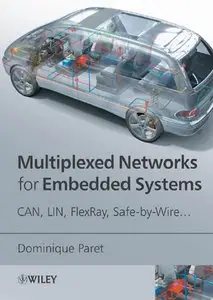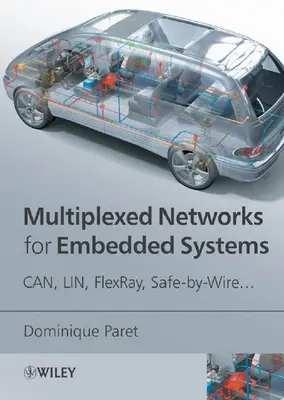"Multiplexed Networks for Embedded Systems: CAN, LIN, Flexray, Safe-by-Wire…" by Dominique Paret
Translated by Roderick Riesco
John Wiley & Sons | 2007 | ISBN: 0470034165 9780470034163 | 433 pages | PDF | 12 MB
Translated by Roderick Riesco
John Wiley & Sons | 2007 | ISBN: 0470034165 9780470034163 | 433 pages | PDF | 12 MB
This book provides a thorough and comprehensive introduction to automotive multiplexed network buses, covering the technical principles, components, implementation issues and applications.
Multiplexed networks are essential for the unified, efficient and cost-effective exchange of electronic information within embedded component systems. This is especially important in automotive manufacturing as vehicles become increasingly reliant on robust electronic networks and systems for improved reliability, anti-lock brake systems (ABS), steering, on-board navigation systems, and much more. The latest systems such as X-by-Wire and FlexRay aim to produce faster, fault-tolerant network component interconnects, for state-of-the-art network implementation and safer, more reliable engineering of vehicular systems.
Contents
Preface
Acknowledgements
Fart A CAN: from concept to reality
1 The CAN has: general
1.1 Concepts of bus access and arbitration
1.2 Eiror processing and management
1.3 Increase your word power
1.4 From concept to reality
1.5 Historical context of CAN
1.6 Patents, licences and certification
2 CAN: its protocol, its properties, its novd features
2.1 Definitions of the CAN protocol: ISO 11898-1 ’
2.2 Errors: their intrinsic properties, detection and processing
2.3 The rest of the frame
2.4 CAN 2.0B
3 The CAN physical layer
3.1 Introduction
3.2 The 'CAN bit’
3.3 Nominal bit time
3.4 CAN and signal propagation
3.5 Bit synchronization
3.6 Network speed
4 Medium, implementation and physical layers in CAN
4.1 The range of media and the types of coupling to the network
4.2 High speed CAN. from 125 kbit s1 to I Mbits-1: ISO 11898
4.3 Low speed CAN. from 10 to 125 kbits-1
4.4 Optical media
4.5 Electromagnetic media
4.6 Pollution and KMC conformity
5 Components, applications and tools for CAN
5.1 CAN components
5.2 Applications
5.3 Application layers and development tools for CAN
6 Time-triggered protocols - HexRay
6.1 Some general remarks
6.2 Kvcnt-triggcrcd and time-triggered aspects
6.3 TTCAN - Time-triggered communication on CAN
6.4 Towards high-speed. X-by-Wire and redundant systems
6.5 Rex Ray
Fart B New multiplexed has concepts: LIN. HexRay. Fail-safe SBC’. Safe-by-Wire
7 LIN - Local Interconnect Network
7.1 Introduction
7.2 Basic concept of the LIN 2.0 protocol
7.3 Cost and market
7.4 Conformity of UN
7.5 Kxamplcs of components for UN 2.0
8 I'hink ‘Bas\ think “Fail-safeSBC’’. “Gateways’ …
8.1 Fail-safe SBCs: their multiple aspects and reasons for using then
8.2 The strategy and principles of te-usc
8.3 Demo board
8.4 Gateways
8.5 Managing the application layers
9 Safe-by-Wire
9.1 A little history
9.2 Safe-by-Wire Plus
9.3 Some words of technology
10 Audio-video btKcs
10.1 I2C Bus
10.2 The D2B (Domestic digital) bus
10.3 The MOST (Media oriented systems transport) bus
10.4 The IEEE 1394 bus or -FireWire’
11 RF communication and wireless mini-networks
11.1 Radio-frequency communication: internal
11.2 Radio-frequency communication: external
11.3 Wireless networks
Conclusion
Fart C Appendices
Appendix A. CiA (CAN in Automation)
Appendix B. Essential references
Appendix C. Further reading
Appendix D. Useful addresses
Index
with TOC BookMarkLinks



